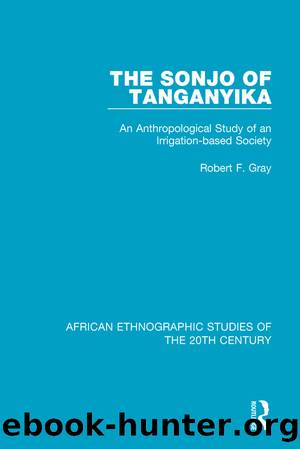The Sonjo of Tanganyika by Robert F. Gray

Author:Robert F. Gray [Gray, Robert F.]
Language: eng
Format: epub
ISBN: 9781138589650
Barnesnoble:
Publisher: Taylor & Francis
Published: 2020-04-29T00:00:00+00:00
BATANA
All the boys in the tribe who are initiated in the same year constitute a closed group of people who are given a distinctive name and recognize special bonds among themselves which last the rest of their lives. I shall call this group an âage-setâ, as it falls within the scope of the definition given to that term by Radcliffe-Brown (1929 : 21): âA recognized and sometimes organized group consisting of persons (often male persons only) who are of the same age.â Despite Radcliffe-Brownâs (1929 : 21) expressed dissatisfaction with the word âclassâ I shall also use this term in the form âwarrior classâ to distinguish the formally organized warriors of a village from other socio-economic classes of men. Thus my terminology for Sonjo age organization includes three concepts. (1) AGE-GRADES are the unchanging institutional forms, a pattern of roles which are filled by generation after generation. The warrior age-grade is subdivided into junior and senior grades with the respective titles of batana barirage (sing, motana moriri) and batana bakolage (sing, motana mokolo). (2) An AGE-SET is a group of men who are initiated in the same year; thereafter they pass from one age-grade to the next together as an organized group. (3) The term AGE-CLASS is used only with reference to the warrior class considered as one of several classes into which Sonjo society is stratified. The warrior class at any one time is composed of two age-sets occupying the respective grades of junior and senior batana.
A Sonjo age-set not only extends through the whole tribe, but is conceived of as encompassing other tribes as well, or at least of being synchronized with the age-grade systems of other tribes. Each age-set has its own name, but the name is not finally decided upon until several years after the set is formed. Some sets fail to agree on a final choice and are known by two alternative names. Nearly all the names are Sonjo versions of Masai names, though the meanings of these names, if they originally had meanings, are not generally known. The age-grade system is not cyclical like the Kipsigis system (Prins, 1953 : 35) but each age-set has a different name with no repetitions. The names of the last eleven age-sets are known to a number of the elders. These are listed below, starting with the oldest and giving the alternative names for those sets possessing them.
Download
This site does not store any files on its server. We only index and link to content provided by other sites. Please contact the content providers to delete copyright contents if any and email us, we'll remove relevant links or contents immediately.
Man-made Catastrophes and Risk Information Concealment by Dmitry Chernov & Didier Sornette(5647)
The Revenge of Geography: What the Map Tells Us About Coming Conflicts and the Battle Against Fate by Kaplan Robert D(3961)
Zero Waste Home by Bea Johnson(3655)
In a Sunburned Country by Bill Bryson(3366)
COSMOS by Carl Sagan(3347)
Good by S. Walden(3346)
The Fate of Rome: Climate, Disease, and the End of an Empire (The Princeton History of the Ancient World) by Kyle Harper(2870)
Camino Island by John Grisham(2719)
A Wilder Time by William E. Glassley(2690)
Organic Mushroom Farming and Mycoremediation by Tradd Cotter(2565)
The Ogre by Doug Scott(2501)
Human Dynamics Research in Smart and Connected Communities by Shih-Lung Shaw & Daniel Sui(2431)
Energy Myths and Realities by Vaclav Smil(2380)
The Traveler's Gift by Andy Andrews(2299)
9781803241661-PYTHON FOR ARCGIS PRO by Unknown(2268)
Inside the Middle East by Avi Melamed(2230)
Birds of New Guinea by Pratt Thane K.; Beehler Bruce M.; Anderton John C(2175)
A History of Warfare by John Keegan(2104)
Ultimate Navigation Manual by Lyle Brotherton(2048)
